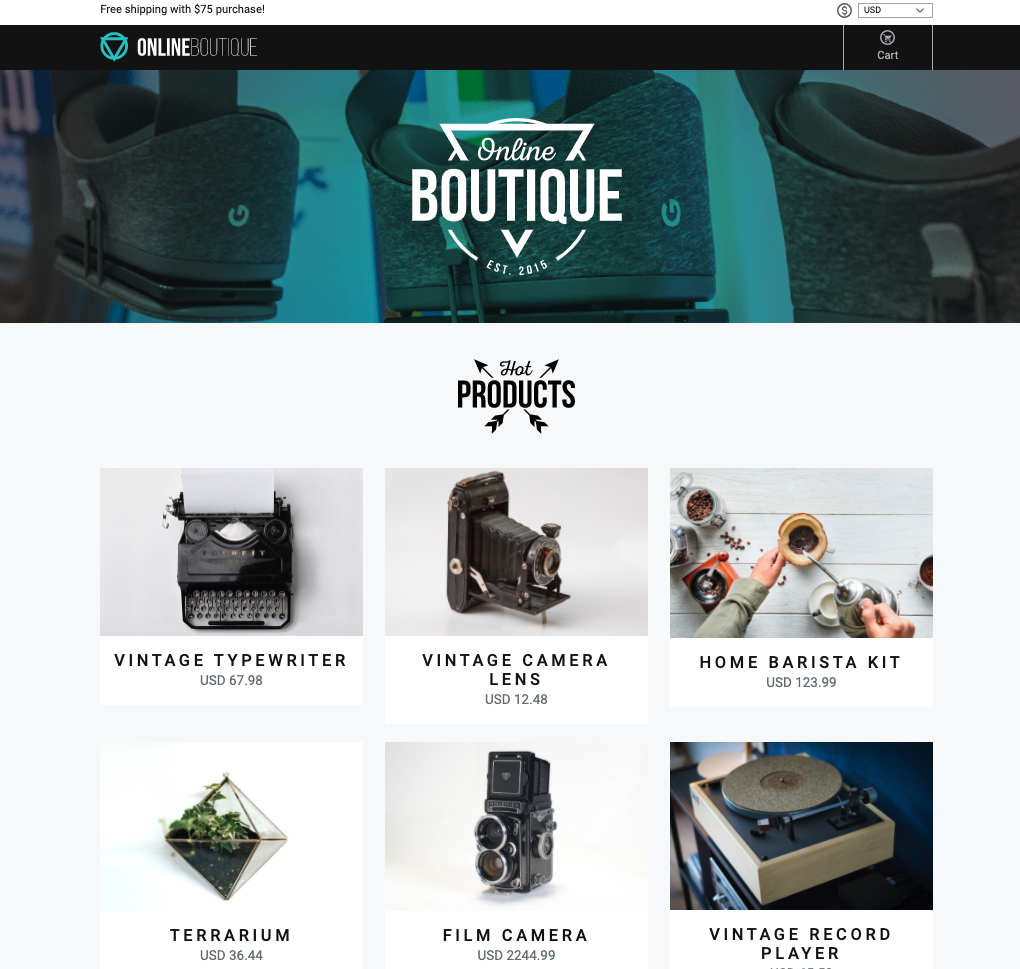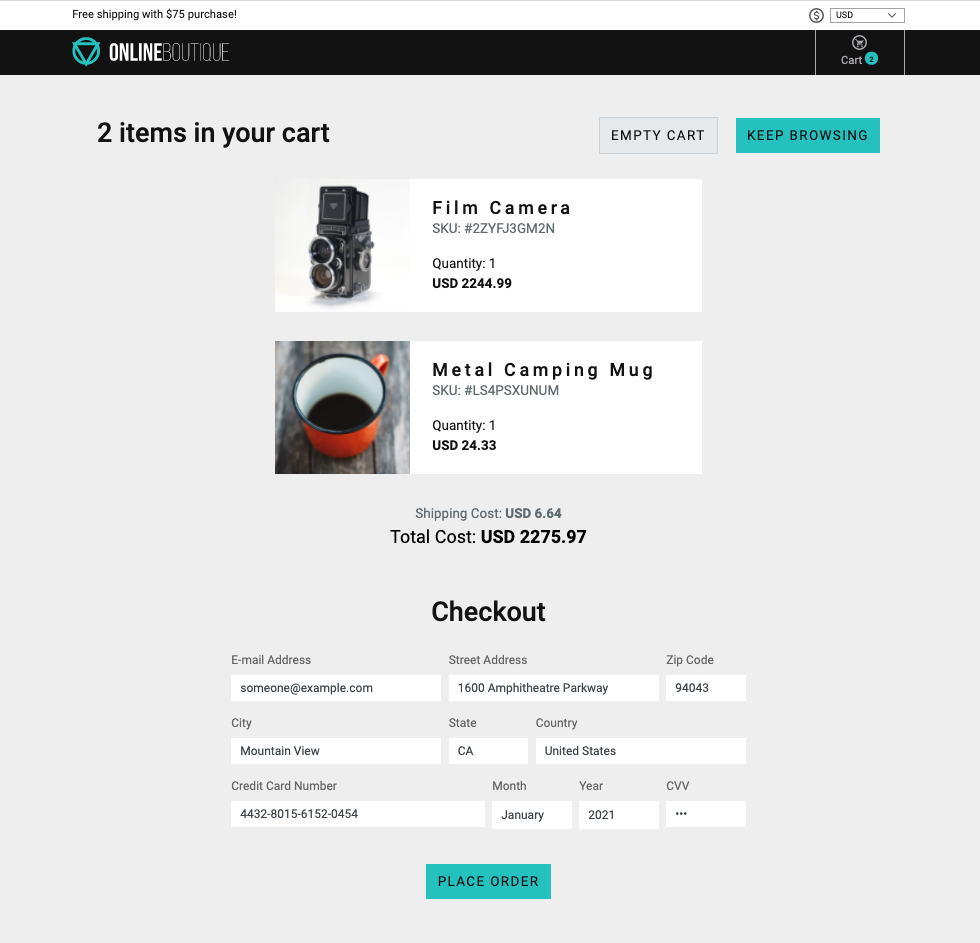Online Boutique is a cloud-native microservices demo application. Online Boutique consists of a 10-tier microservices application. The application is a web-based e-commerce app where users can browse items, add them to the cart, and purchase them.
This application works on any Kubernetes cluster (such as a local one), as well as Google Kubernetes Engine. It’s easy to deploy with little to no configuration.
If you’re using this demo, please ★Star this repository to show your interest!
| Home Page | Checkout Screen |
|---|---|
 |
 |
Online Boutique is composed of many microservices written in different languages that talk to each other over gRPC.
Find Protocol Buffers Descriptions at the ./pb directory.
| Service | Language | Description |
|---|---|---|
| frontend | Go | Exposes an HTTP server to serve the website. Does not require signup/login and generates session IDs for all users automatically. |
| cartservice | C# | Stores the items in the user's shopping cart in Redis and retrieves it. |
| productcatalogservice | Go | Provides the list of products from a JSON file and ability to search products and get individual products. |
| currencyservice | Node.js | Converts one money amount to another currency. Uses real values fetched from European Central Bank. It's the highest QPS service. |
| paymentservice | Node.js | Charges the given credit card info (mock) with the given amount and returns a transaction ID. |
| shippingservice | Go | Gives shipping cost estimates based on the shopping cart. Ships items to the given address (mock) |
| emailservice | Python | Sends users an order confirmation email (mock). |
| checkoutservice | Go | Retrieves user cart, prepares order and orchestrates the payment, shipping and the email notification. |
| recommendationservice | Python | Recommends other products based on what's given in the cart. |
| adservice | Java | Provides text ads based on given context words. |
| loadgenerator | Python/Locust | Continuously sends requests imitating realistic user shopping flows to the frontend. |
- Kubernetes/GKE: The app is designed to run on Kubernetes (both locally on "Docker for Desktop", as well as on the cloud with GKE).
- gRPC: Microservices use a high volume of gRPC calls to communicate to each other.
- Skaffold: Application is deployed to Kubernetes with a single command using Skaffold.
- Synthetic Load Generation: The application demo comes with a background job that creates realistic usage patterns on the website using Locust load generator.
We offer the following installation methods:
-
Running locally (~20 minutes) You will build and deploy microservices images to a single-node Kubernetes cluster running on your development machine. There are three options to run a Kubernetes cluster locally for this demo:
- Minikube. Recommended for Linux hosts (also supports Mac/Windows).
- Docker for Desktop. Recommended for Mac/Windows.
- Kind. Supports Mac/Windows/Linux.
-
Running on Google Kubernetes Engine (GKE)” (~30 minutes) You will build, upload and deploy the container images to a Kubernetes cluster on Google Cloud.
- kubectl (can be installed via
gcloud components install kubectl) - Local Kubernetes cluster deployment tool:
- Minikube (recommended for Linux)
- Docker for Desktop (recommended for Mac/Windows)
- It provides Kubernetes support as noted here
- Kind
- skaffold (ensure version ≥v1.10)
- Enable GCP APIs for Cloud Monitoring, Tracing, Debugger:
gcloud services enable monitoring.googleapis.com \ cloudtrace.googleapis.com \ clouddebugger.googleapis.com
💡 Recommended if you're planning to develop the application or giving it a try on your local cluster.
-
Launch a local Kubernetes cluster with one of the following tools:
-
To launch Minikube (tested with Ubuntu Linux). Please, ensure that the local Kubernetes cluster has at least:
- 4 CPU's
- 4.0 GiB memory
- 32 GB disk space
minikube start --cpus=4 --memory 4096 --disk-size 32g
-
To launch Docker for Desktop (tested with Mac/Windows). Go to Preferences:
- choose “Enable Kubernetes”,
- set CPUs to at least 3, and Memory to at least 6.0 GiB
- on the "Disk" tab, set at least 32 GB disk space
-
To launch a Kind cluster:
kind create cluster
-
-
Run
kubectl get nodesto verify you're connected to “Kubernetes on Docker”. -
Run
skaffold run(first time will be slow, it can take ~20 minutes). This will build and deploy the application. If you need to rebuild the images automatically as you refactor the code, runskaffold devcommand. -
Run
kubectl get podsto verify the Pods are ready and running. -
Access the web frontend through your browser
- Minikube requires you to run a command to access the frontend service:
minikube service frontend-external
-
Docker For Desktop should automatically provide the frontend at http://localhost:80
-
Kind does not provision an IP address for the service. You must run a port-forwarding process to access the frontend at http://localhost:8080:
kubectl port-forward deployment/frontend 8080:8080
💡 Recommended if you're using Google Cloud Platform and want to try it on a realistic cluster.
-
Create a Google Kubernetes Engine cluster and make sure
kubectlis pointing to the cluster.gcloud services enable container.googleapis.comgcloud container clusters create demo --enable-autoupgrade \ --enable-autoscaling --min-nodes=3 --max-nodes=10 --num-nodes=5 --zone=us-central1-akubectl get nodes -
Enable Google Container Registry (GCR) on your GCP project and configure the
dockerCLI to authenticate to GCR:gcloud services enable containerregistry.googleapis.comgcloud auth configure-docker -q
-
In the root of this repository, run
skaffold run --default-repo=gcr.io/[PROJECT_ID], where [PROJECT_ID] is your GCP project ID.This command:
- builds the container images
- pushes them to GCR
- applies the
./kubernetes-manifestsdeploying the application to Kubernetes.
Troubleshooting: If you get "No space left on device" error on Google Cloud Shell, you can build the images on Google Cloud Build: Enable the Cloud Build API, then run
skaffold run -p gcb --default-repo=gcr.io/[PROJECT_ID]instead. -
Find the IP address of your application, then visit the application on your browser to confirm installation.
kubectl get service frontend-externalTroubleshooting: A Kubernetes bug (will be fixed in 1.12) combined with a Skaffold bug causes load balancer to not to work even after getting an IP address. If you are seeing this, run
kubectl get service frontend-external -o=yaml | kubectl apply -f-to trigger load balancer reconfiguration.
If you've deployed the application with skaffold run command, you can run
skaffold delete to clean up the deployed resources.
If you've deployed the application with kubectl apply -f [...], you can
run kubectl delete -f [...] with the same argument to clean up the deployed
resources.
This repository is based on Google microservice demo
